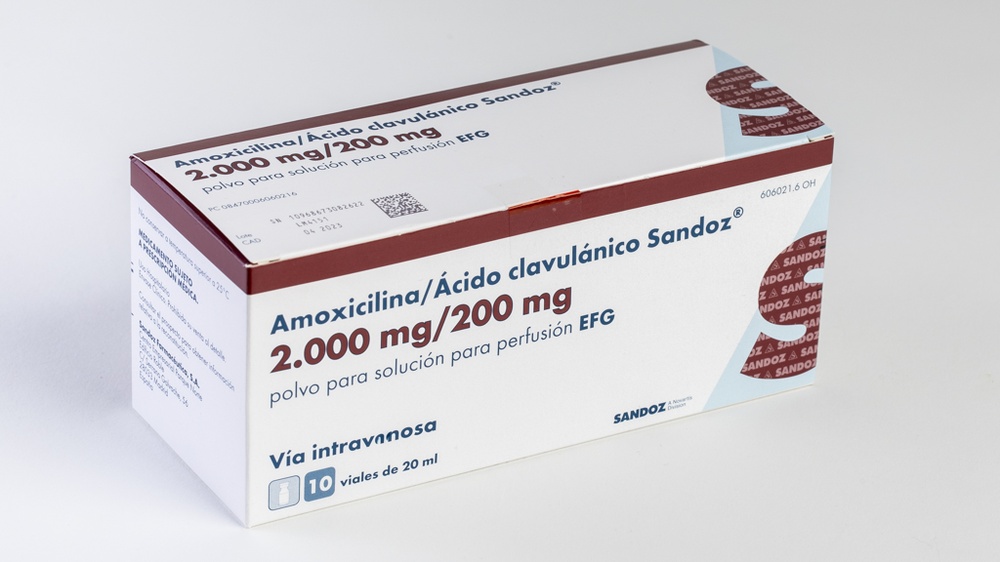

AMOXICILINA/ÁCIDO CLAVULÂNICO SANDOZ 2000mg/200mg PÓ PARA SOLUÇÃO PARA PERFUSÃO

Pergunte a um médico sobre a prescrição de AMOXICILINA/ÁCIDO CLAVULÂNICO SANDOZ 2000mg/200mg PÓ PARA SOLUÇÃO PARA PERFUSÃO

Como usar AMOXICILINA/ÁCIDO CLAVULÂNICO SANDOZ 2000mg/200mg PÓ PARA SOLUÇÃO PARA PERFUSÃO
Introdução
Prospecto: informação para o utilizador
Amoxicilina/Ácido clavulânico Sandoz 2000mg/200mg pó para solução para perfusão EFG
Leia todo o prospecto detenidamente antes de começar a usar este medicamento, porque contém informações importantes para si.
- Conservar este prospecto, porque pode ter que voltar a lê-lo.
- Se tiver alguma dúvida, consulte o seu médico, farmacêutico ou enfermeiro.
- Este medicamento foi prescrito apenas para si, e não deve dá-lo a outras pessoas, mesmo que tenham os mesmos sintomas que si, porque pode prejudicá-las.
- Se experimentar efeitos adversos, consulte o seu médico, farmacêutico ou enfermeiro, mesmo que se trate de efeitos adversos que não aparecem neste prospecto. Ver seção 4.
Conteúdo do prospecto:
- O que é Amoxicilina/Ácido clavulânico Sandoz e para que é utilizado
- O que precisa saber antes de começar a usar Amoxicilina/Ácido clavulânico Sandoz
- Como usar Amoxicilina/Ácido clavulânico Sandoz
- Efeitos adversos possíveis
- Conservação de Amoxicilina/Ácido clavulânico Sandoz
- Conteúdo do envase e informações adicionais.
1. O que é Amoxicilina/Ácido clavulânico Sandoz e para que é utilizado
Amoxicilina/ácido clavulânico é um antibiótico que elimina as bactérias que causam infecções. Contém dois medicamentos diferentes chamados amoxicilina e ácido clavulânico. Amoxicilina pertence ao grupo de medicamentos conhecido como “penicilinas” que por vezes pode perder a sua eficácia (inativa-se). O outro componente (ácido clavulânico) evita que isso ocorra.
Os antibióticos são utilizados para tratar infecções bacterianas e não servem para tratar infecções virais como a gripe ou o resfriado.
É importante que siga as instruções relativas à dose, às tomas e à duração do tratamento indicadas pelo seu médico.
Não guarde nem reutilize este medicamento. Se uma vez finalizado o tratamento lhe sobrar antibiótico, devolva-o à farmácia para a sua correta eliminação. Não deve deitar os medicamentos pelo esgoto nem para o lixo.
Amoxicilina/ácido clavulânico é utilizado em adultos e crianças para tratar as seguintes infecções:
- infecções agudas de ouvido, nariz e garganta,
- infecções do trato respiratório,
- infecções do trato urinário,
- infecções da pele e tecidos moles incluíndo infecções dentárias,
- infecções dos ossos e da pele,
- infecções intra-abdominais,
- infecções genitais em mulheres.
Amoxicilina/ácido clavulânico é utilizado em adultos para prevenir infecções associadas a processos de cirurgia maior.
2. O que precisa saber antes de começar a usar Amoxicilina/Ácido clavulânico Sandoz
Não use Amoxicilina/Ácido clavulânico Sandoz:
- se é alérgico aos princípios ativos ou a algum dos outros componentes deste medicamento (incluídos na seção 6)
- se alguma vez teve uma reação alérgica grave (de hipersensibilidade) a qualquer outro antibiótico. Isso poderia incluir erupção cutânea ou inchaço de face ou pescoço,
- se alguma vez teve problemas de fígado ou icterícia (coloração amarelada da pele) ao tomar um antibiótico.
Não receba Amoxicilina/Ácido clavulânico Sandoz se algum dos pontos anteriores lhe aplica. Se não tiver certeza, consulte o seu médico, farmacêutico ou enfermeiro.
Advertências e precauções
Consulte o seu médico, farmacêutico ou enfermeiro antes de começar a usar amoxicilina/ácido clavulânico se:
- tem mononucleose infecciosa,
- está a receber tratamento para problemas de fígado ou rim,
- não urina regularmente.
Se não tiver certeza de se algum dos sintomas anteriores o afeta, informe o seu médico, farmacêutico ou enfermeiro antes de receber Amoxicilina/Ácido clavulânico.
Em alguns casos, o seu médico pode investigar o tipo de bactéria que está a causar a sua infecção. Dependendo dos resultados, pode que lhe prescrevam uma apresentação diferente de amoxicilina/ácido clavulânico ou outro medicamento.
Sintomas a que deve estar atento
Amoxicilina/ácido clavulânico pode agravar determinadas condições existentes, ou causar efeitos adversos graves. Estes incluem reações alérgicas, convulsões e inflamação do intestino grosso. Deve estar atento a determinados sintomas enquanto lhe é administrada amoxicilina/ácido clavulânico, para reduzir o risco de problemas. Ver “Sintomas a que deve estar atento” na seção4.
Análises de sangue e urina
Se lhe estão a ser realizadas análises de sangue (como estudos do estado dos glóbulos vermelhos ou estudos de função hepática) ou análises de urina (para controlar os níveis de glicose), informe o seu médico ou enfermeiro de que lhe está a ser administrada amoxicilina/ácido clavulânico. Isso é porque amoxicilina/ácido clavulânico pode alterar os resultados desses tipos de análises.
Uso de Amoxicilina/Ácido clavulânico Sandoz com outros medicamentos
Informe o seu médico ou farmacêutico se está a utilizar, utilizou recentemente ou possa ter que utilizar qualquer outro medicamento, mesmo os adquiridos sem receita e medicamentos à base de plantas.
Se está a tomar alopurinol (utilizado para a gota) com amoxicilina/ácido clavulânico, pode ser mais provável que tenha uma reação alérgica cutânea.
Probenecida (utilizada para tratar a gota), o uso concomitante de probenecida pode reduzir a excreção de amoxicilina e não é recomendado.
Se tomar anticoagulantes (como warfarina) com amoxicilina/ácido clavulânico são necessárias mais análises de sangue.
Metotrexato (medicamento empregado para tratar o cancro e psoríase grave), as penicilinas podem reduzir a excreção de metotrexato e causar um aumento potencial dos efeitos adversos.
Amoxicilina/ácido clavulânico pode afetar a forma como actua micofenolato de mofetila (um medicamento utilizado para prevenir o rejeição de órgãos em pacientes transplantados).
Gravidez e amamentação
Se está grávida ou em período de amamentação, acredita que possa estar grávida ou tem intenção de engravidar, consulte o seu médico, farmacêutico ou enfermeiro antes de utilizar este medicamento.
Amoxicilina/Ácido clavulânico Sandoz contém sódio e potássio
Este medicamento contém 118 mg de sódio por frasco equivalente a 5,9 % da ingestão máxima diária de 2 g de sódio recomendada pela OMS para um adulto.
Este medicamento contém menos de 39 mg (1 mmol) de potássio por frasco, pelo que se considera essencialmente “isento de potássio”
3. Como usar Amoxicilina/Ácido clavulânico Sandoz
Nunca se vai administrar a si mesmo este medicamento. Uma pessoa qualificada, como um médico ou uma enfermeira, o administrará.
As doses normais são:
Adultos e crianças que pesam 40 kg ou mais
Dose padrão | 1.000 mg/100 mg cada 8-12 horas. |
Dose superior | 1.000 mg/100 mg cada 8 horas ou 2.000 mg/200 mg cada 12 horas Para infecções muito graves, a dose pode aumentar até 2.000 mg/200 mg cada 8 horas. |
Para evitar as infecções durante e após a cirurgia. | De 1.000 mg/100 mg a 2.000 mg/200 mg antes da cirurgia quando lhe administram o anestésico. A dose pode variar dependendo do tipo de operação que lhe vão realizar. O seu médico pode repetir a dose, se a cirurgia durar mais de uma hora. |
Crianças que pesam menos de 40 kg
- Todas as doses são calculadas com base no peso corporal da criança em quilogramas.
Crianças de 3 meses ou mais: | 50 mg/5 mg por cada quilograma de peso corporal cada 8 horas. |
Crianças de menos de 3 meses e que pesem menos de 4 kg | 50 mg/5 mg por cada quilograma de peso corporal cada 12 horas. |
Pacientes com problemas de rim e fígado
- se tem problemas de rim pode que lhe alterem a dose. Pode que o seu médico escolha uma apresentação diferente ou outro medicamento,
- se tem problemas de fígado far-se-ão análises sanguíneas mais frequentemente para comprovar como funciona o seu fígado.
Como lhe vai ser administrada Amoxicilina/Ácido clavulânico Sandoz
- amoxicilina/ácido clavulânico vai ser administrada como perfusão intravenosa,
- certifique-se de beber muito líquido enquanto recebe amoxicilina/ácido clavulânico,
- não lhe vai ser administrada amoxicilina/ácido clavulânico durante mais de duas semanas sem que o médico revise o tratamento.
Se usar mais Amoxicilina/Ácido clavulânico Sandoz do que deve
É muito pouco provável que lhe sejam administradas demasiadas amoxicilina/ácido clavulânico, mas se pensar que lhe foram administradas demasiadas diga-o ao seu médico, farmacêutico ou enfermeiro imediatamente. Os sintomas podem ser mal-estar de estômago (náuseas, vómitos ou diarreia) ou convulsões.
Se tiver mais perguntas sobre como se administra este produto, consulte o seu médico, farmacêutico ou enfermeiro.
4. Efeitos adversos possíveis
Como todos os medicamentos, este medicamento pode produzir efeitos adversos, embora nem todas as pessoas os sofram.
Os seguintes efeitos adversos podem ter lugar com este medicamento.
Sintomas a que deve estar atento
Reações alérgicas:
- erupção cutânea,
- inflamação dos vasos sanguíneos (vasculite) que pode aparecer como pontos vermelhos ou roxos, na pele, mas que pode afetar outras partes do corpo,
- febre, dor de articulações, glândulas inchadas no pescoço, axilas ou virilhas,
- inchaço por vezes da face ou boca (angioedema), que causa dificuldade para respirar,
- colapso,
- dor no peito no contexto de reações alérgicas, que pode ser um sintoma de enfarte cardíaco desencadeado por alergia (síndrome de Kounis).
- Síndrome de enterocolite induzida por fármaco (DIES): Foi notificado DIES principalmente em crianças que recebem amoxicilina. É um certo tipo de reação alérgica com o sintoma principal de vómitos repetitivos (de 1-4 horas após a administração do medicamento). Outros sintomas podem incluir dor abdominal, letargia, diarreia e pressão arterial baixa.
Contacte com o seu médico imediatamentese sofrer algum destes sintomas. Deixe de administrar Amoxicilina/Ácido clavulânico Sandoz.
Inflamação do intestino grosso
Inflamação do intestino grosso, que causa diarreia aquosa normalmente com sangue e muco, dor de estômago e/ou febre.
Contacte com o seu médico o mais breve possívelpara que lhe aconselhe se tiver estes sintomas.
Efeitos adversos frequentes (podem afetar até 1 de cada 10 pacientes)
- aftas (candida – infecção por fungos na vagina, boca ou mucosas),
- diarreia.
Efeitos adversos pouco frequentes(podem afetar até 1 de cada 100 pacientes)
- erupção cutânea, picazón,
- erupção pruriginosa aumentada (habão urticarial),
- náuseas, especialmente quando se administram doses altas,
se lhe acontecer isto, administre amoxicilina/ácido clavulânico antes das refeições
- vómitos,
- indigestão,
- tonturas,
- dor de cabeça.
Efeitos adversos pouco frequentes que podem aparecer nas análises de sangue:
- aumento em algumas substâncias (enzimas) produzidas pelo fígado.
Efeitos adversos raros (podem afetar até 1 de cada 1.000 pacientes)
- erupção da pele, que pode formar bolhas que parecem pequenas dianas (ponto central escuro rodeado por uma área mais pálida, com um anel escuro à volta do bordo - eritema multiforme),
Se tiver algum destes sintomas, contacte um médico urgentemente.
- inchaço e vermelhidão ao longo da veia, que é extremamente sensível ao toque.
Efeitos adversos raros que podem aparecer nas análises de sangue ou de urina:
- baixo recuento das células implicadas na coagulação do sangue,
- baixo recuento de glóbulos brancos.
Outros efeitos adversos
Outros efeitos adversos que ocorreram em um número muito pequeno de pacientes e cuja frequência exacta não é conhecida:
- reações alérgicas (ver acima),
- inflamação do intestino grosso (ver acima),
- inflamação das membranas que envolvem o cérebro e a medula espinhal (meningite asséptica),
- reações cutâneas graves:
- erupção generalizada com bolhas e descamação da pele, particularmente à volta da boca, nariz, olhos e genitais (síndrome de Stevens-Johnson), e na sua forma mais grave, causando uma descamação generalizada da pele (mais de 30% da superfície corporal – necrólise epidérmica tóxica),
- erupção generalizada com pequenas bolhas com pus (dermatite exfoliativa bolhosa),
- erupção vermelha, com bultos debaixo da pele e bolhas (pustulose exantemática).
- sintomas de tipo gripal com erupção cutânea, febre, inflamação de glândulas e resultados anormais nas análises de sangue (como aumento dos leucócitos (eosinofilia) e elevação das enzimas hepáticas) (reação a fármaco com eosinofilia e sintomas sistémicos (DRESS)),
- erupção com bolhas dispostas em círculo com crosta central ou como um colar de pérolas (doença por IgA linear).
Contacte um médico imediatamente se tiver algum destes sintomas.
- inflamação do fígado (hepatite),
- inflamação aguda do pâncreas (pancreatite aguda); se tiver dor intensa e contínua na área do estômago, isto pode ser um sinal de pancreatite aguda,
- icterícia, causada pelo aumento de bilirrubina no sangue (uma substância produzida pelo fígado), que pode fazer com que a pele e o branco dos olhos se tornem amarelentos,
- inflamação dos condutos dos rins,
- atraso na coagulação do sangue,
- convulsões (em pacientes que tomam doses elevadas de amoxicilina/ácido clavulânico ou que têm problemas renais).
Efeitos adversos que podem aparecer nas análises de sangue ou de urina:
- redução importante no número de glóbulos brancos,
- baixo recuento de glóbulos vermelhos (anemia hemolítica),
- cristais na urina que provocam uma lesão renal aguda.
Comunicação de efeitos adversos
Se experimentar algum tipo de efeito adverso, consulte o seu médico ou farmacêutico, mesmo que se trate de possíveis efeitos adversos que não aparecem neste prospecto. Também pode comunicá-los directamente através do Sistema Espanhol de Farmacovigilância de medicamentos de Uso Humano: https://www.notificaram.es. Mediante a comunicação de efeitos adversos, você pode contribuir para fornecer mais informações sobre a segurança deste medicamento.
5. Conservação de Amoxicilina/Ácido clavulânico Sandoz
A data de validade e instruções de armazenamento da etiqueta são para informação do médico ou enfermeiro. O médico, farmacêutico ou enfermeiro reconstituirá o seu medicamento, que deve ser utilizado dentro dos 15 minutos da reconstituição.
Não conserve a uma temperatura superior a 25ºC.
Mantenha este medicamento fora da vista e do alcance das crianças.
Não utilize Amoxicilina/Ácido clavulânico Sandoz após a data de validade que aparece no envase. A data de validade é o último dia do mês que se indica.
Os medicamentos não devem ser deitados pelos esgotos nem para o lixo. Pergunte ao seu farmacêutico como se livrar dos envases e dos medicamentos que não precisa. Deste modo, ajudará a proteger o meio ambiente.
6. Conteúdo do envase e informação adicional
Composição de Amoxicilina/Ácido clavulânico Sandoz
Cada frasco contém como princípios ativos 2.000 mg de amoxicilina (como amoxicilina sódica) e 200 mg de ácido clavulânico (como clavulanato potássico).
Não contém excipientes.
Aspecto do produto e conteúdo do envase
Frascos que contêm um pó estéril de cor branca a esbranquiçada.
Envases de 1 ou 50 frascos de 100 ml.
Envases de 1 ou 10 frascos de 20 ml.
Título de autorização de comercialização e responsável pela fabricação
Título de autorização de comercialização
Sandoz Farmacêutica, S.A.
Centro Empresarial Parque Norte
Edifício Roble
Rua Serrano Galvache, 56
28033 Madrid
Espanha
Responsável pela fabricação
Sandoz GmbH
Biochemiestrasse, 10
A-6250 Kundl
Áustria
Data da última revisão deste prospecto:fevereiro 2023.
A informação detalhada e atualizada deste medicamento está disponível na página web da Agência Espanhola de Medicamentos e Produtos Sanitários (AEMPS) http://www.aemps.gob.es/
-------------------------------------------------------------------------------------------------------------------
Esta informação está destinada apenas a médicos ou profissionais do setor sanitário:
Por favor, verifique a Ficha técnica para informação adicional
Administração
Amoxicilina/ácido clavulânico Sandoz 2.000 mg/200 mg pó para solução para perfusão, deve ser administrado por perfusão durante 30 a 40 minutos. Amoxicilina/ácido clavulânico Sandoz não é adequado para administração intramuscular.
Reconstituição
Para uso único. Qualquer solução não utilizada deve ser descartada.
A reconstituição e diluição devem ser realizadas sob condições assépticas. A solução deve ser verificada visualmente antes da administração, para detectar qualquer partícula estranha e decoloração. A solução só deve ser usada se for transparente e livre de partículas.
A reconstituição e diluição da solução para perfusão intravenosa devem ser realizadas no momento da administração. Amoxicilina/ácido clavulânico Sandoz 2000 mg/200 mg não é adequado para injeção intravenosa rápida (bolus).
Amoxicilina/ácido clavulânico Sandoz 2.000 mg/200 mg deve ser reconstituído em 20 ml de água para preparações injetáveis (este é um volume mínimo). Pode ser observada uma coloração rosa pálida durante a reconstituição. As soluções reconstituídas são normalmente incolores ou com uma cor de palha pálida.
Imediatamente, a solução reconstituída deve ser adicionada a 100 ml de fluido de perfusão usando uma minibolsa ou bureta em linha.
Não devem ser usadas como solventes soluções injetáveis de glicose (dextrose) de bicarbonato de sódio ou de dextrano.
De maneira geral, recomenda-se não misturar com nenhum outro produto na mesma seringa ou frasco de perfusão. A associação de amoxicilina e ácido clavulânico é incompatível com: sangue e plasma, hidrocortisona succinato, soluções de aminoácidos, hidrolisados de proteínas, emulsões de lípidos, fenilefrina HCl, soluções de manitol.
Amoxicilina/ácido clavulânico Sandoz não deve ser misturado na mesma seringa com antibióticos aminoglicosídeos, pois nestas condições pode ocorrer uma perda de atividade do aminoglicosídeo.
Os frascos de Amoxicilina/ácido clavulânico Sandoz não são adequados para uso em doses múltiplas.
Estabilidade das soluções preparadas
Frasco reconstituído (antes da diluição para perfusão)
A dissolução obtida após a reconstituição (1 frasco com 20 ml de água para injetáveis) demonstrou ser estável do ponto de vista químico e físico durante 15 minutos a 25 °C ± 2°C/ 60% ±5% HR.
Frasco reconstituído e diluído para perfusão
A dissolução obtida ao diluir imediatamente o frasco reconstituído com 100 ml de água para injetáveis ou NaCl 0,9% ou lactato de sódio 1/6M ou solução de Ringer ou solução de Hartmann demonstrou ser estável do ponto de vista químico e físico durante 60 minutos a 25°C ± 2°C/ 60% ±5% HR.
Qualquer solução de antibiótico não utilizada deve ser descartada.
- País de registo
- Substância ativa
- Requer receita médicaSim
- Fabricante
- Esta informação é apenas para referência e não constitui aconselhamento médico. Consulte sempre um médico antes de tomar qualquer medicamento. A Oladoctor não se responsabiliza por decisões médicas baseadas neste conteúdo.
- Alternativas a AMOXICILINA/ÁCIDO CLAVULÂNICO SANDOZ 2000mg/200mg PÓ PARA SOLUÇÃO PARA PERFUSÃOForma farmacêutica: SOLUÇÃO/SUSPENSÃO ORAL, 250 mg de amoxicilina/62,5 mg de ácido clavulânicoSubstância ativa: amoxicillin and beta-lactamase inhibitorFabricante: Sandoz Farmaceutica S.A.Requer receita médicaForma farmacêutica: PERFURAÇÃO INJETÁVEL, 2 g / 200 mgSubstância ativa: amoxicillin and beta-lactamase inhibitorFabricante: Laboratorio Reig Jofre, S.A.Requer receita médicaForma farmacêutica: COMPRIMIDO, 500 mg de amoxicilina/125 mg de ácido clavulânicoSubstância ativa: amoxicillin and beta-lactamase inhibitorFabricante: Sun Pharmaceutical Industries (Europe) B.V.Requer receita médica
Alternativas a AMOXICILINA/ÁCIDO CLAVULÂNICO SANDOZ 2000mg/200mg PÓ PARA SOLUÇÃO PARA PERFUSÃO noutros países
As melhores alternativas com o mesmo princípio ativo e efeito terapêutico.
Alternativa a AMOXICILINA/ÁCIDO CLAVULÂNICO SANDOZ 2000mg/200mg PÓ PARA SOLUÇÃO PARA PERFUSÃO em Polónia
Alternativa a AMOXICILINA/ÁCIDO CLAVULÂNICO SANDOZ 2000mg/200mg PÓ PARA SOLUÇÃO PARA PERFUSÃO em Ukraine
Médicos online para AMOXICILINA/ÁCIDO CLAVULÂNICO SANDOZ 2000mg/200mg PÓ PARA SOLUÇÃO PARA PERFUSÃO
Avaliação de posologia, efeitos secundários, interações, contraindicações e renovação da receita de AMOXICILINA/ÁCIDO CLAVULÂNICO SANDOZ 2000mg/200mg PÓ PARA SOLUÇÃO PARA PERFUSÃO – sujeita a avaliação médica e regras locais.















